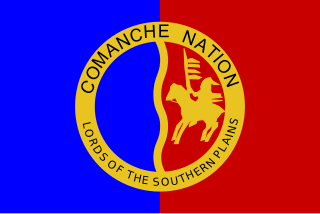
The Comanche or Nʉmʉnʉʉ are a Native American nation from the Great Plains of the present-day United States. Their historic territory consisted of most of present-day northwestern Texas and adjacent areas in eastern New Mexico, southeastern Colorado, southwestern Kansas, western Oklahoma, and northern Chihuahua. Within the United States, the government federally recognizes the Comanche people as the Comanche Nation, headquartered in Lawton, Oklahoma. The Comanche language is a Numic language of the Uto-Aztecan family. It was originally a Shoshoni dialect, but has diverged over time to become a separate language.

Ellis County is a county located on the western border of the U.S. state of Oklahoma. As of the 2010 census, the population was 4,151, making it the fifth-least populous county in Oklahoma. Its county seat is Arnett.

Comanche County is a county located in the U.S. state of Oklahoma. As of the 2010 census, the population was 124,098, making it the fourth-most populous county in Oklahoma. Its county seat is Lawton. The county was created in 1901 as part of Oklahoma Territory. It was named for the Comanche tribal nation.

Cache is a city in Comanche County, Oklahoma, United States. The population was 2,796 at the 2010 census. It is an exurb included in the Lawton, Oklahoma Metropolitan Statistical Area. It is the location of Star House, the home of the Comanche chief Quanah Parker, the major leader of the Quahadi Comanche in the years of Indian Wars and transition to reservation life.

Waurika is the county seat of Jefferson County, Oklahoma, United States. The population was 2,064 at the 2010 census, a 4.36 percent decrease from 2,158 at the 2000 census.

Comanche is a city in Stephens County, Oklahoma, United States. The population was 1,663 at the 2010 census.

Quanah is a city in and the county seat of Hardeman County, Texas, United States. As of the 2010 census the population was 2,641, down from 3,022 at the 2000 census.

The Fort Parker massacre of May 1836, also known as the Fort Parker raid, was an event in which U.S. settlers of the Parker family were killed in an attack by a contingent of Comanche, Caddo, and Wichita fighters. During the attack, Cynthia Ann Parker, then 9-years-old, was captured and spent most of the rest of her life within the Comanche Nation, later marrying Chief Peta Nocona and giving birth to a son, Quanah Parker, who became a prominent leader of the Comanches and a war leader during the Red River War of 1874–75. Parker’s brother John Richard Parker was also captured and remained with the Comanches for six years before his released was negotiated. He was unable to readapt to Western society and chose to return to the Comanche Nation.

Quanah Parker was a war leader of the Kwahadi ("Antelope") band of the Comanche Nation. He was likely born into the Nokoni ("Wanderers") band of Tabby-nocca and grown up among the Kwahadis, the son of Kwahadi Comanche chief Peta Nocona and Cynthia Ann Parker, an Anglo-American who had been kidnapped as a child and assimilated into the Nokoni tribe. Following the apprehension of several Kiowa chiefs in 1871, Quanah Parker emerged as a dominant figure in the Red River War, clashing repeatedly with Colonel Ranald S. Mackenzie. With European-Americans hunting American bison, the Comanches' primary sustenance, into near extinction, Quanah Parker eventually surrendered and peaceably led the Kwahadi to the reservation at Fort Sill, Oklahoma.
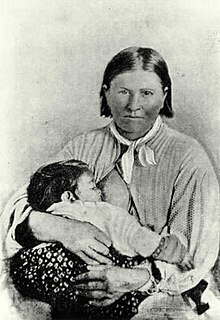
Cynthia Ann Parker, also known as Naduah, was a white woman who was kidnapped in 1836, around age nine, by a Comanche war band which had attacked her family's settlement, and was then discovered and captured by the Texas Rangers, at approximately age 33, when they attacked her adopted tribe. Her Comanche name means "someone found" in English.

The Comanche Wars were a series of armed conflicts fought between Comanche peoples and Spanish, Mexican, and American militaries and civilians in the United States and Mexico from as early as 1706 until at least the mid-1870s. The Comanche were the Native American inhabitants of a large area known as Comancheria, which stretched across much of the southern Great Plains from Colorado and Kansas in the north through Oklahoma, Texas, and eastern New Mexico and into the Mexican state of Chihuahua in the south. For more than 150 years, the Comanche were the dominant native tribe in the region, known as “the Lords of the Southern Plains”, though they also shared parts of Comancheria with the Wichita, Kiowa, and Kiowa Apache and, after 1840, the southern Cheyenne and Arapaho.
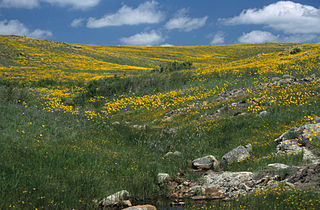
Wichita Mountains Wildlife Refuge, located in southwestern Oklahoma near Lawton, has protected unique wildlife habitats since 1901 and is the oldest managed wildlife facility in the United States Fish and Wildlife Service system. The refuge's location in the geologically unique Wichita Mountains and its areas of undisturbed mixed grass prairie make it an important conservation area. The Wichitas are approximately 500 million years old. Measuring about 59,020 acres (238.8 km2), the refuge hosts a great diversity of species: 806 plant species, 240 species of birds, 36 fish, and 64 reptiles and amphibians are present.
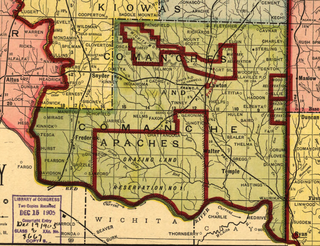
The Big Pasture was 488,000 acres (1,975 km2) of prairie land, in what is now southwestern Oklahoma. The land had been reserved for grazing use by the Kiowa, Comanche, and Apache tribes after their reserve was opened for settlement by a lottery conducted during June through August 1901. The tribes, however, leased most of the land out to large ranchers and it became known as Big Pasture. The Big Pasture was maintained for grazing until June 5, 1906, when Congress passed an act requiring that it be disposed of by allotting 160 acres (0.6 km2), in severalty, to each child born into the tribes after the act of 1900. The remaining land was sold by sealed bid in December 1906 and the proceeds placed in the U.S. Treasury for the tribes. This was the last large tract of land opened for settlement in Oklahoma Territory.
State Highway 49 (SH-49) is a 30-mile-long (48 km) state highway in the U.S. state of Oklahoma. It runs from SH-54 in Kiowa County to Interstate 44 (I-44) near Lawton. Part of the highway runs through the Wichita Mountains Wildlife Refuge; this portion of SH-49 carries no signage identifying it as such. It has no lettered spur routes.

The Quartz Mountains are an extension of the Wichita Mountains in the far southwestern part of the state of Oklahoma. According to the Encyclopedia of Oklahoma History and Culture, the range was originally formed about 550 million years ago as a "failed continental rift". It was uplifted about 300 million years ago and has since weathered into its current condition. The unique geography provides cover for the most northerly population of live oak, quercus fusiformis. This rare oak is generally regarded as the most cold hardy evergreen oak.

Isatai'i, Isatai, or Eschiti was a Comanche warrior and medicine man of the Kwaharʉ band. Originally named Kwihnai Tosabitʉ, after the debacle at Adobe Walls on June 27, 1874, for which he was blamed, he was known as Isatai'i. Isatai'i gained enormous prominence for a brief period in 1873-74 as a prophet and "messiah" of Native Americans. He succeeded, albeit temporarily, in uniting the autonomous Comanche bands as no previous Chief or leader had ever done. Indeed, his prestige was such that he was able to organize what was said to be the first Comanche sun dance, a ritual that his tribe had not previously adopted.

The Quanah Parker Star House, with stars painted on its roof, is located in the city of Cache, county of Comanche, in the U.S. state of Oklahoma. It was added to the National Register of Historic Places listings in Comanche County, Oklahoma, in 1970.
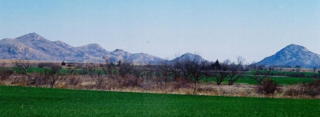
Navajoe is a ghost town in Jackson County, Oklahoma, United States, located eight miles east and four miles north of Altus at the base of the Navajo Mountains.

Clear Creek Lake is a reservoir located in Stephens County, Oklahoma, approximately 13 miles (21 km) northeast of Duncan, Oklahoma. It was built in 1948 with an earthen dam. It is one of four lakes that are collectively known as the "Duncan Area Lakes."

Ketch Ranch House or Ketch Ranch was private property located in the Wichita Mountains of Southwestern Oklahoma. The ranch was established as a working ranch and vacation home for Ada May Ketch and Frank Levant Ketch during the early 1920s. The Wichita Mountain ranch offered a guest house, barn, smokehouse, springhouse, and root cellar while providing outdoor experiences with horseback riding, boating, and fishing at Ketch Lake which was close proximity of 1 mile (1.6 km) from the Ketch Ranch House.



















